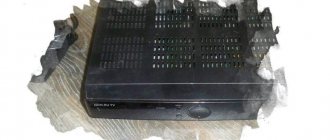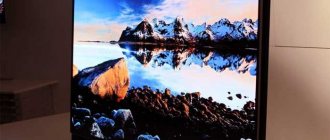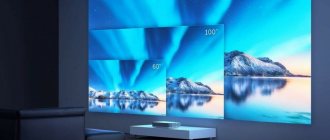The Matrix on TV - what is it?
The matrix in a TV screen is a combination of a layer of liquid crystals and small colorless electrodes. They are located either vertically or horizontally, but always parallel to each other.
The main composition of the matrix is a cell with a liquid crystal that retains its structure. The size does not exceed half a millimeter.
Light rays are passed through this material. As a result, shade modeling is instant and complete, which allows you to get a good visual result.
The cell is divided into 3 segments:
- blue;
- red;
- green.
Colors form a pixel, i.e. a point that, together with its own kind, produces an image.
If you move the matrix diagram onto a regular white sheet of A4 paper, you can see a regular nesting grid in the shape of a square. It turns out that the matrix is a plane with small lights. They are the ones who provide the image.
The system is located among the plates. Depending on the design of the TV, they can be made of glass or plastic. This fact is not of great importance.
The matrix in the TV screen is responsible for the quality:
- permissions;
- contrast;
- brightness;
- response time (the minimum time it takes for a pixel to change brightness);
- image stabilization.
The main purpose of the matrix is to display illustrations on the monitor.
Advantages and disadvantages of LCD TVs
These TVs have a number of advantages:
- Energy efficiency;
- Use of environmental technologies;
- Durability;
- Light weight and dimensions of the TV;
- No glare in bright light;
- Low cost compared to other models of modern TVs.
However, in comparison with other modern technologies used in televisions, LCD displays also have certain disadvantages:
- Insufficient image contrast;
- Low black depth due to the use of additional backlighting;
- Poor color reproduction, especially in older TV models;
- High refresh rate;
- Small viewing angle, especially in older TVs.
In the end, I would like to say that all the shortcomings are mainly present in older models. Modern TV has almost completely gotten rid of such problems and is practically no different from other technologies.
Types of LCD matrices
There are only 3 types of matrices. The principle of their operation is very similar, but the picture quality and price range of TVs vary significantly.
TN
The name comes from English words. If translated literally, it turns out that TN-Film is a twisted crystal made of non-metal. In this technology, all elements in cells are in the shape of a spiral.
Advantages of the matrix
:
- when compared with other systems, TN has minimal monitor response;
- the price tag for TV with this technology is low;
- maximum energy savings.
Minuses:
- the viewing angle is insignificant in all planes;
- color intensity is quite low;
- The black color is replaced by highlights of a gray shade.
IPS or SFT
Hitachi specialists worked on the creation. Afterwards, other leading TV manufacturers also paid attention to this type of matrix. This is the most popular type of matrix.
The name itself can be translated as switching in different planes.
Advantages:
- viewing angles are maximum;
- color rendering is significantly better than other types of LCD matrices;
- true depth of color as measured by the RGB standard.
Flaws:
- long monitor response time;
- pixelation is very noticeable on small TVs (less than 17 inches diagonal);
- the price of a device with such a system is high.
V.A.
Translated, it means vertical adjustment. In this case, there is no spiral twisting of the elements. Light does not go beyond liquid crystals.
Pros of the system:
- here is the highest level of contrast;
- full black tone, no gray tint;
- realistic color scheme.
There is one downside to the technology. If you change the viewing angle even a centimeter contrary to what was specified by the manufacturer, the colors begin to “dance.”
Not long ago, the VA matrix had a receiver - MVA. The creators of this system worked on the flaw. The viewing angle has increased.
Each matrix considered now uses special films and voltage amplification. They help improve image quality.
Other characteristics of LCD TVs
| Brightness, black depth and contrast | The brightness of such TVs is at a fairly high level, but the contrast leaves much to be desired. This is due to the fact that with the polarization effect, the depth of black color will be as much as the backlight allows. Due to insufficient black depth and contrast, dark shades may merge into one color. |
| Screen diagonal | Today you can easily find LCD panels with both large diagonals, which can be used as a home theater, and models with rather small diagonals. |
| Viewing angle | Modern TV models have a fairly good viewing angle, which can reach 180 degrees. But older models don't have enough angle, which can cause the screen to look quite dark or the colors to be distorted when looking at the screen from certain angles. |
| Color rendition | The color rendering of such displays is not always of quite good quality. This again applies mainly to older screen models. But modern models are often inferior to other types of TV. |
| Energy efficiency | LCD displays consume 40% less electricity than other types. |
| Dimensions and weight | Such TVs are quite light in weight and thickness, but today there are panels with less thickness and weight. |
LED matrices
This system is based on LEDs. They act as a replacement for fluorescent lamps with diodes. They allow you to organize the lighting of each pixel separately. The result is a high-quality black color.
LEDs were preferred due to the fact that they consume less electricity and do not adversely affect human vision.
There are 2 types of LED backlight:
- Along the edges of the monitor.
Thanks to them, manufacturers can produce plasma panels with a thin screen. This technology is called EDGE. - Throughout the area.
Allows maximum illumination of the center of the device and creates the illusion of a “big screen”. The technology is called DIRECT.
TFT display device: Video
Of course, knowing all these nuances, people who process photographs prefer IPS matrices, since they do not require fast response, but at the same time they need the most natural color rendition. In other cases, the type of matrix does not matter.
And, of course, all characteristics depend on the manufacturer, as well as on the technology and materials used. Do not think that all IPS matrices are the same; they can also differ from each other. It is worth understanding that the more expensive the monitor (or TV), the higher image quality you can get. The same can be said about TN+Film matrices.
Whatever LCD display you choose, you should definitely familiarize yourself with its capabilities and technical characteristics. Today, LCD displays are the most common for a number of reasons. You already know their advantages. Thanks to this, they are direct competitors to plasma panels, but at the same time they have a lower cost, which makes them more accessible to users. In addition, they have a greater resource. In other words, the LCD display lasts significantly longer than the plasma panel.
LCD matrix
The main component—liquid crystal—under the influence of galvanic current is capable of changing the inclination of the molecule in space. This is how color is managed.
The LCD matrix includes:
- layer of liquid crystals;
- colorless electrodes, which are placed on both edges of the crystal plate, and control the throughput;
- screen backlight;
- a filter responsible for the tone and intensity of the pixel;
- component that covers the front part of the matrix.
How to find out what matrix is on the TV?
Large device manufacturers attach a sticker to the equipment with a detailed description of the features/technical capabilities of the screen. The original packaging also indicates the technologies used.
Information about TVs is available on the official websites of branded manufacturers, including the type of matrix.
If the information is hidden and could not be found, then there are a number of other methods for determining the type of matrix:
- Look at the display at an angle.
If the TV has a built-in TN matrix, then the illustration will be dark and the color will be distorted. With VA, all colors will take on a lighter shade. But the image quality of IPS will remain unchanged. - Click on the screen.
Only a TV with IPS technology will leave the image the same. In all other cases, the picture will be spoiled. - Try to find damaged pixels.
For IPS this area will be black, and for TN it will be white.
Fast response and the required value for watching 3D video
Response speed is how many frames per second the TV can display. This setting affects the image quality and smoothness. In order for this quality to be achieved, the refresh rate must be 120 Hz. In order to achieve this frequency, TVs use a video card. In addition, this frame rate does not create screen flickering, which in turn is better for the eyes.
To watch movies in 3D format, this refresh rate will be quite enough. At the same time, many TVs have a backlight that has a refresh rate of 480 Hz. This is achieved by using special TFT transistors.
Which matrix should I choose?
Before buying a plasma panel, you need to pay attention to 2 factors: the cost of the product and your own requirements. There are a huge number of TVs on the market with different matrices.
After the pricing policy has been determined, decide where and what the TV is needed for:
- A TV with a TN matrix is perfect for a cottage, kitchen or office.
They are small in size (about 32 inches). A TN matrix can be selected if the screen will be used as a gaming monitor. - For home theater it is better to give preference to IPS and VA.
TVs with such technologies display videos of any format well, regardless of viewing angle. You can use IPS and VA for presentations where photo clarity is important. - For private viewing of channels with your family, VA is suitable.
TVs are inexpensive. The image quality is not high.
Types of backlight
Liquid crystal displays also differ in the types of backlighting.
- Plasma or gas discharge lamps. Initially, all LSD monitors were backlit by one or more lamps. Basically, such lamps had a cold cathode and were called CCFL. Later, EEFL lamps began to be used. The light source in such lamps is plasma, which appears as a result of an electrical discharge passing through a gas. At the same time, you should not confuse LCD TV with plasma TV, in which each of the pixels is an independent light source.
- LED backlight or LED. Such TVs appeared relatively recently. Such displays have one or more LEDs. However, it is worth noting that this is only the type of backlight, and not the display itself, which consists of these miniature diodes.
Matrix faults
Clarity, brightness and color fullness are the main advantages of modern TVs. Sometimes the illustration becomes cloudy, doubles, etc. These are signs of a matrix malfunction.
A system malfunction can be determined by other defects:
- along colored vertical floors that appear instead of video footage;
- along dark circles;
- for uncharacteristic stains, i.e. not those left after wet cleaning;
- along minor horizontal lines;
- by dots of different shades that do not disappear spontaneously.
The following factors lead to matrix failure:
- hitting the monitor with great force (this breaks the unity of the conductors);
- penetration of moisture even in small quantities causes malfunction of the electrodes;
- The matrix is defective, i.e. the TV is poorly assembled; the defect becomes noticeable after 2-3 months of operation.
If there is no damage visible to the human eye, then only a service center specialist will help deal with the breakdown.
Features of matrix replacement
You can replace the matrix at home. Before doing this, you should read the instructions. The procedure is very scrupulous and requires care.
Step-by-step instructions for replacing the matrix
Replacing the matrix is quite difficult. To avoid negative consequences, follow the algorithm of actions:
- Disconnect the device from the cable and cable. Move the device to the place where replacement work will be carried out.
- Separate the front part of the matrix from the back. Use a screwdriver to tighten the screws that hold the parts together.
- Place the outer component matrix towards the bottom. It should not be placed on a soft surface (thick cardboard, carpet).
- Unfasten the latches. Do not manipulate with a knife under any circumstances. It's best to take a piece of plate.
- Disconnect the electrical wire and signal cable from the matrix system.
- The junction of the cable and the matrix is glued with adhesive tape before assembly. Carefully remove the tape. Be careful, sudden movement will damage the components of the device. Remove the damaged matrix.
- Prepare the new matrix for installation. Wipe the edges with a cloth soaked in an alcohol solution. Install fasteners made of metal.
- Install a new system. Connect the signal cable and power cable. Check if the TV is working.
- Assemble the device body. Then install a safety display made of acrylic.
You can clearly see the instructions from the video:
Do not forget to match the supplied matrix with the TV control module. Sometimes, after replacement, the illustration is not displayed on the screen.
Changes are made through the main menu of the device. A detailed description of the process is always in the documentation for the equipment.
Plasma panels
The picture on the plasma screen appears due to the glow of the phosphor, which, in turn, is heated by ultraviolet rays. Here, each cell is a separate light source, independent of other elements. That is, “plasma” simply does not need backlighting as such. Only three brands produce such panels - Samsung, Panasonic and LG. They also repair broken TV matrices in their official service centers.
Advantages of plasma panels:
- excellent color rendition and depth of gamut;
- the presence of a 2D volumetric effect;
- natural black color;
- excellent display of dynamic content;
- minimal screen response;
- maximum viewing angles;
- thin body.
Flaws:
- plasma technology has a residual image, which means the TV will not work normally with a PC;
- mediocre display of static backgrounds (not for viewing photos);
- high energy consumption;
- high price even for models in the budget segment.










